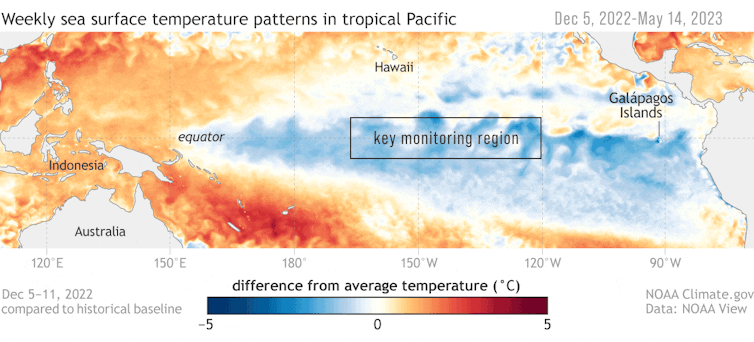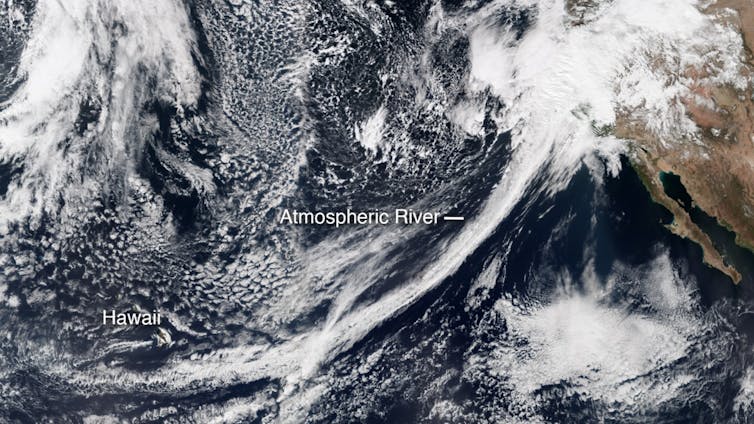News
Atmospheric rivers are shifting poleward, reshaping global weather patterns

Zhe Li, University Corporation for Atmospheric Research
Atmospheric rivers – those long, narrow bands of water vapor in the sky that bring heavy rain and storms to the U.S. West Coast and many other regions – are shifting toward higher latitudes, and that’s changing weather patterns around the world.
The shift is worsening droughts in some regions, intensifying flooding in others, and putting water resources that many communities rely on at risk. When atmospheric rivers reach far northward into the Arctic, they can also melt sea ice, affecting the global climate.
In a new study published in Science Advances, University of California, Santa Barbara, climate scientist Qinghua Ding and I show that atmospheric rivers have shifted about 6 to 10 degrees toward the two poles over the past four decades.
Atmospheric rivers on the move
Atmospheric rivers aren’t just a U.S West Coast thing. They form in many parts of the world and provide over half of the mean annual runoff in these regions, including the U.S. Southeast coasts and West Coast, Southeast Asia, New Zealand, northern Spain, Portugal, the United Kingdom and south-central Chile.
California relies on atmospheric rivers for up to 50% of its yearly rainfall. A series of winter atmospheric rivers there can bring enough rain and snow to end a drought, as parts of the region saw in 2023.
While atmospheric rivers share a similar origin – moisture supply from the tropics – atmospheric instability of the jet stream allows them to curve poleward in different ways. No two atmospheric rivers are exactly alike.
What particularly interests climate scientists, including us, is the collective behavior of atmospheric rivers. Atmospheric rivers are commonly seen in the extratropics, a region between the latitudes of 30 and 50 degrees in both hemispheres that includes most of the continental U.S., southern Australia and Chile.
Our study shows that atmospheric rivers have been shifting poleward over the past four decades. In both hemispheres, activity has increased along 50 degrees north and 50 degrees south, while it has decreased along 30 degrees north and 30 degrees south since 1979. In North America, that means more atmospheric rivers drenching British Columbia and Alaska.
A global chain reaction
One main reason for this shift is changes in sea surface temperatures in the eastern tropical Pacific. Since 2000, waters in the eastern tropical Pacific have had a cooling tendency, which affects atmospheric circulation worldwide. This cooling, often associated with La Niña conditions, pushes atmospheric rivers toward the poles.
The poleward movement of atmospheric rivers can be explained as a chain of interconnected processes.
During La Niña conditions, when sea surface temperatures cool in the eastern tropical Pacific, the Walker circulation – giant loops of air that affect precipitation as they rise and fall over different parts of the tropics – strengthens over the western Pacific. This stronger circulation causes the tropical rainfall belt to expand. The expanded tropical rainfall, combined with changes in atmospheric eddy patterns, results in high-pressure anomalies and wind patterns that steer atmospheric rivers farther poleward.

Conversely, during El Niño conditions, with warmer sea surface temperatures, the mechanism operates in the opposite direction, shifting atmospheric rivers so they don’t travel as far from the equator.
The shifts raise important questions about how climate models predict future changes in atmospheric rivers. Current models might underestimate natural variability, such as changes in the tropical Pacific, which can significantly affect atmospheric rivers. Understanding this connection can help forecasters make better predictions about future rainfall patterns and water availability.
Why does this poleward shift matter?
A shift in atmospheric rivers can have big effects on local climates.
In the subtropics, where atmospheric rivers are becoming less common, the result could be longer droughts and less water. Many areas, such as California and southern Brazil, depend on atmospheric rivers for rainfall to fill reservoirs and support farming. Without this moisture, these areas could face more water shortages, putting stress on communities, farms and ecosystems.
In higher latitudes, atmospheric rivers moving poleward could lead to more extreme rainfall, flooding and landslides in places such as the U.S. Pacific Northwest, Europe, and even in polar regions.
In the Arctic, more atmospheric rivers could speed up sea ice melting, adding to global warming and affecting animals that rely on the ice. An earlier study I was involved in found that the trend in summertime atmospheric river activity may contribute 36% of the increasing trend in summer moisture over the entire Arctic since 1979.
What it means for the future
So far, the shifts we have seen still mainly reflect changes due to natural processes, but human-induced global warming also plays a role. Global warming is expected to increase the overall frequency and intensity of atmospheric rivers because a warmer atmosphere can hold more moisture.
How that might change as the planet continues to warm is less clear. Predicting future changes remains uncertain due largely to the difficulty in predicting the natural swings between El Niño and La Niña, which play an important role in atmospheric river shifts.
As the world gets warmer, atmospheric rivers – and the critical rains they bring – will keep changing course. We need to understand and adapt to these changes so communities can keep thriving in a changing climate.
Zhe Li, Postdoctoral Researcher in Earth System Science, University Corporation for Atmospheric Research
This article is republished from The Conversation under a Creative Commons license. Read the original article.
The science section of our news blog STM Daily News provides readers with captivating and up-to-date information on the latest scientific discoveries, breakthroughs, and innovations across various fields. We offer engaging and accessible content, ensuring that readers with different levels of scientific knowledge can stay informed. Whether it’s exploring advancements in medicine, astronomy, technology, or environmental sciences, our science section strives to shed light on the intriguing world of scientific exploration and its profound impact on our daily lives. From thought-provoking articles to informative interviews with experts in the field, STM Daily News Science offers a harmonious blend of factual reporting, analysis, and exploration, making it a go-to source for science enthusiasts and curious minds alike. https://stmdailynews.com/category/science/
Discover more from Daily News
Subscribe to get the latest posts sent to your email.
Economy
6 Wild Truths About America’s 2025 Spending Habits: Fetch Reveals Surprising Consumer Trends
The Fetch Finds Report reveals that in 2025, Americans balanced hard work with self-care, reflecting a mix of discipline and indulgence. Notable trends included a resurgence in meat sales, increased dining out, a focus on organization, and a rise in comfort-related purchases.
The Fetch Finds Report reveals a year of hustle, comfort, and delightfully chaotic shopping carts
Americans in 2025 were a study in contradictions. We hit the gym but also hit the couch. We decluttered our homes while filling our carts. We powered through demanding days with energy gels and powered down with weighted blankets and candles.
That’s the picture painted by Fetch’s first-ever full-year Fetch Finds Report, which analyzed more than $179 billion in consumer transactions. With 12 million receipts submitted daily, the data tells a story that’s equal parts discipline and indulgence—a snapshot of a nation trying to balance the hustle with some much-needed comfort.
6 Wild Truths About America’s 2025 Spending Habits: Fetch Reveals Surprising Consumer Trends
The Six Spending Surprises of 2025
1. The Meatless Revolution Has Expired
Remember when plant-based everything was the future? In 2025, Americans said “thanks, but no thanks” and brought meat back to the table. Fresh beef sales jumped 13%, pork climbed 12%, while refrigerated plant-based alternatives dropped 11%. Despite rising grocery costs, consumers chose the real deal over the meatless alternatives.
2. America’s Eating Out—and Sushi’s on a Roll
Even with tighter budgets, dining out surged. And the big winner? Sushi, with a massive 45.6% increase in trip growth. Mexican restaurants saw a respectable 13.9% bump, and pizza grew 6.7%. But sushi absolutely dominated the dining-out conversation this year.
3. Endurance Nutrition Takes a Victory Lap
Energy chews and gels jumped 27.4% in 2025. Whether Americans were actually running marathons or just trying to survive Monday morning meetings, endurance nutrition became a go-to for powering through demanding days.
4. The Great American Declutter Hit Overdrive
Self-care became shelf-care. Household storage bags surged 55.8%, charging valets climbed 37%, and cleaning gloves rose 13.4%. Getting organized wasn’t just about tidiness—it became an act of wellness. A clean space, a clear mind.
5. Protein Moved into the Pantry
Protein isn’t just for gym bros anymore. Everyday staples got a protein makeover:
- Protein-labeled breakfast cereals: +69.8%
- Protein granola: +45.9%
- Protein dry pasta: +35.4%
Consumers wanted their regular foods to work harder, turning breakfast and dinner into opportunities to fuel up.
6. America Powered Down and Got Comfortable
Comfort became the ultimate status symbol. Loungewear sales soared 218%, weighted blankets climbed 45%, and candles rose 20%. After all that hustle, Americans made winding down a priority—and they weren’t shy about investing in it.
What This Tells Us
The Fetch Finds Report captures something real about 2025: Americans were navigating a shifting economy with a mix of practicality and self-care. We pushed hard during the day and gave ourselves permission to relax at night. We organized our homes, fueled our bodies with protein, and treated ourselves to sushi dinners and cozy nights in.
“Fetch sees what others can’t: how people actually spend based on billions of purchases,” said Jacob Grocholski, Vice President of Analytics at Fetch. “This year, we saw a chaotic mix of discipline and indulgence that defined how people navigated 2025.”
About the Data
The findings come from Fetch, America’s Rewards App, which captures billions of spending transactions annually using AI and machine learning. With more than 6 million five-star reviews and users submitting 12 million receipts daily, Fetch has unmatched visibility into what consumers actually buy—at the item level, across every channel and retailer.
Want the full breakdown? Read the complete Fetch Finds Report for all the details on America’s 2025 spending habits.
For the latest news, trends, and stories that matter, head over to STM Daily News. From entertainment and tech to community features and in-depth reporting, we’ve got you covered. Visit us at stmdailynews.com and stay in the know.
Discover more from Daily News
Subscribe to get the latest posts sent to your email.
News
CES 2026: The Exhibitors and Moments That Stood Out for Entertainment + Tech Fans
CES 2026 delivered big entertainment-tech moments—from Sony Honda’s AFEELA to streaming, smart glasses, AI PCs, and robots that stole the show.

CES 2026 (Jan. 6–9 in Las Vegas) didn’t feel like a “future tech” show as much as a “right now” show. The big shift: AI wasn’t treated like a standalone product category anymore. It was the invisible layer powering everything from streaming discovery to robots that can actually do work.
For STM Daily News readers who live in the overlap of Entertainment and Tech, here are the exhibitors and trends that stood out most—plus why they matter beyond the show floor.
1) Sony Honda Mobility (AFEELA): The car as a rolling entertainment platform
Sony Honda Mobility’s AFEELA presence reinforced a direction CES keeps leaning into: the next generation of vehicles is competing as much on software and in-cabin experience as it is on horsepower.
What made it stand out:
- AFEELA represents the “car as a connected device” idea taken seriously—where the cabin becomes a screen-first, service-driven environment.
- It’s a clean example of how mobility and entertainment are merging: navigation, safety, personalization, and media all living in one interface.
2) Netflix + Amazon Prime Video + Roku + Xumo: Streaming is evolving into ecosystems
CES 2026’s Content & Entertainment story wasn’t about “who has the most subscribers.” It was about streaming as an ecosystem: bundling, ad-supported growth, and smarter discovery.
What made it stand out:
- CES highlighted how streaming platforms are pushing beyond simple libraries into bundles, premium originals, and integrated experiences.
- FAST (free ad-supported streaming TV) continues to gain traction, and device/platform players are positioning themselves as the front door.
3) Dolby: The quiet power behind the best-looking, best-sounding experiences
Dolby isn’t always the flashiest booth, but it consistently shows up as the tech that makes everything else feel “premium.”
What made it stand out:
- In a year where screens, XR, and immersive venues are everywhere, audio and imaging standards are the difference between “cool demo” and “wow.”
- Dolby’s relevance keeps growing as entertainment moves across phones, living rooms, cars, and wearables.
4) Meta + XREAL: Smart glasses keep inching toward mainstream
Wearables at CES 2026 weren’t just about steps and sleep. The momentum was in smart glasses and AR—especially as generative AI voice interfaces make hands-free use feel more natural.
What made it stand out:
- CES noted smart/AR glasses evolving with features like real-time translation, recording, and AI voice interfaces.
- For entertainment fans, this is where “watching” and “doing” start to blend—live overlays, creator tools, and new ways to capture experiences.
5) Samsung + LG + TCL: Screens are still the show’s main stage
Even in an AI-everywhere year, CES still belongs to display tech. Big brands kept proving that TVs aren’t just TVs—they’re hubs for gaming, streaming, smart home control, and ambient experiences.
What made it stand out:
- Display leaders continue to set the tone for how entertainment is consumed at home.
- The conversation is shifting from specs to experience: personalization, AI-powered recommendations, and multi-device continuity.
6) NVIDIA + AMD + Lenovo: The “AI PC” era is no longer theoretical
CES 2026 made it clear that the next wave of consumer computing is built around on-device AI. That matters for creators, editors, and anyone who lives in content.
What made it stand out:
- CES highlighted AI’s move from “digital transformation” to “intelligent transformation,” including edge/enterprise and physical AI in robotics.
- AMD’s CES keynote emphasized AI across devices from PCs to data centers, underscoring how quickly this is becoming standard.
7) Unitree + Richtech Robotics + Hyundai: Robots were the surprise crowd-pleaser
If CES 2026 had a “you had to see it” category, it was robotics. Not just novelty bots—machines built for real environments.
What made it stand out:
- CES framed robotics as “physical AI,” where generative AI and simulation training help robots learn faster than traditional programming.
- Humanoid robots, in particular, are moving from single-task demos toward more collaborative assistant roles.
The big takeaway for STM Daily News readers
CES 2026 wasn’t about one killer gadget. It was about convergence:
- Entertainment is becoming more interactive, more personalized, and more portable.
- Cars are becoming screens.
- Wearables are becoming interfaces.
- Robots are becoming the next “device category” people actually want to watch.
And underneath it all: AI is becoming less of a headline and more of the operating system for modern life.
Here’s a list of what stood out to us at CES 2026:
- Sony Honda Mobility (AFEELA): The car as a rolling entertainment platform
- Netflix + Amazon Prime Video + Roku + Xumo: Streaming is evolving into ecosystems
- Dolby: The quiet power behind the best-looking, best-sounding experiences
- Meta + XREAL: Smart glasses keep inching toward mainstream
- Samsung + LG + TCL: Screens are still the show’s main stage
- NVIDIA + AMD + Lenovo: The “AI PC” era is no longer theoretical
- Unitree + Richtech Robotics + Hyundai: Robots were the surprise crowd-pleaser
Sources
- CES press release recap and exhibitor/topic highlights (Jan. 9, 2026): https://www.ces.tech/press-releases/ces-2026-the-future-is-here
Dive into “The Knowledge,” where curiosity meets clarity. This playlist, in collaboration with STMDailyNews.com, is designed for viewers who value historical accuracy and insightful learning. Our short videos, ranging from 30 seconds to a minute and a half, make complex subjects easy to grasp in no time. Covering everything from historical events to contemporary processes and entertainment, “The Knowledge” bridges the past with the present. In a world where information is abundant yet often misused, our series aims to guide you through the noise, preserving vital knowledge and truths that shape our lives today. Perfect for curious minds eager to discover the ‘why’ and ‘how’ of everything around us. Subscribe and join in as we explore the facts that matter. https://stmdailynews.com/the-knowledge/
Discover more from Daily News
Subscribe to get the latest posts sent to your email.
actors & performers
T.K. Carter, The Thing and Punky Brewster Actor, Dies at 69
Actor T.K. Carter, known for The Thing and Punky Brewster, has died at age 69. A look at his career and lasting legacy in film and television.
Veteran actor T.K. Carter, best known for his roles in The Thing and the popular 1980s television series Punky Brewster, has died at the age of 69.
Authorities confirmed Carter was found unresponsive at his home in Duarte, California. No foul play is suspected, and an official cause of death has not yet been released.
A Career Spanning Decades
Born Thomas Kent Carter, T.K. Carter built a career in film and television that spanned more than four decades. He became a cult favorite portraying Nauls in John Carpenter’s 1982 horror classic The Thing, a film that continues to influence the genre today.
Television audiences widely remember Carter for his role as Mike Fulton on Punky Brewster, where his comedic timing and grounded performances helped make the show a lasting favorite of the era.
Film and Television Legacy
In addition to his best-known roles, Carter appeared in films such as Runaway Train, Ski Patrol, and Space Jam. His television work included guest appearances on a wide range of series throughout the 1980s, 1990s, and beyond.
Known within the industry as a reliable and versatile performer, Carter often brought authenticity and warmth to supporting roles that left a lasting impression, even in brief appearances.
Remembering T.K. Carter
As news of his passing spreads, fans and colleagues alike are reflecting on T.K. Carter’s contributions to film and television. While he may not have always been the leading name on the marquee, his work helped shape stories that continue to be watched and appreciated by new generations.
T.K. Carter is remembered for his enduring performances, professional dedication, and the quiet but meaningful legacy he leaves behind.
Related Coverage
- Los Angeles Times: Actor T.K. Carter Dies at 69
- People Magazine: T.K. Carter, ‘The Thing’ and ‘Punky Brewster’ Actor, Dead at 69
- Entertainment Weekly: T.K. Carter, ‘Punky Brewster’ and ‘The Thing’ Actor, Dies
- ABC News: Veteran Actor T.K. Carter Dies at 69
Stay with STM Daily News for updates to this developing story and more independent coverage of entertainment, history, and culture. Visit www.stmdailynews.com for the latest.
Discover more from Daily News
Subscribe to get the latest posts sent to your email.
